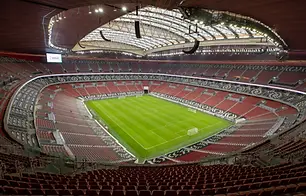World-class venues designed for the FIFA World Cup 2022, each reflecting Qatar’s culture, innovation, and hospitality.

Ahmad Bin Ali Stadium
The stadium is built in the city of Al Rayyan and acts as a landmark for those arriving or leaving the city. It holds the FIFA Sustainability Award for its sustainable practices and is designed to be accessible and provide an inclusive football experience for everyone. It is surrounded by green spaces, walking trails, and a range of entertainment options.

Al Janoub Stadium
The stadium is shaped like the sails of traditional pearl diver Dhow boats with the seating stands on the inside designed like the waves of the sea. Its pitch was laid in 2019 in a record time of 9 hours and 15 minutes, and can be reconfigured for different sports, such as rugby and athletics.

Abdullah Bin Khalifa Stadium
Named after Qatar’s former Prime Minister, the arena features modern facilities and hosts high-profile matches in a compact setting. The design of the stadium features traditional Qatari aesthetics with cutting-edge technology, and the interplay of light and shadows falling into the stadium creates a compelling spectacle during sunset.
.jpg)
Jassim Bin Hamad Stadium
Originally built in 1974, this iconic venue is among Qatar’s most prestigious sports arenas. It is designed with a retractable roof that can be opened or closed depending on the weather. Beyond the football pitch, the stadium complex boasts a range of facilities, including a café, a mosque, an athletics track and a multi-sports hall.

Education City Stadium
The stadium's diamond-like design represents durability, resilience, and value to the country, while the intricate diamond patterns on its façade change colour with the sun's movement. It has a capacity of 44,667 fans and has hosted plenty of high-profile matches across different tournaments. Facilities include football training pitches, a golf course and shops.

Al Bayt Stadium
The stadium, shaped like a traditional Bedouin tent, boasting a sustainable design with a retractable roof, is the largest cylindrical stadium in the world, with a capacity of 68,000 fans. The word Bayt is the Arabic word for ‘home’, and its design depicts the Qatari traditional tents and their warmth. The opening game of the FIFA World Cup Qatar 2022™ was hosted here.

Lusail Stadium
With a capacity of 80,000 fans, its futuristic design drew inspiration from the fanar lantern's play of light and shadow. The shape and facade reflect intricate decorative motifs from the golden age of Arab and Islamic art. The stadium's innovative design relies on solar power for cooling, boasting a zero carbon footprint.

Khalifa International Stadium
Named after the Emir of Qatar, Khalifa bin Hamad Al Thani, the Khalifa International Stadium is Qatar’s oldest stadium and has been its premier football venue since its inauguration in the 1970s. Starting in 2014, the stadium underwent significant renovations which included upgrading the stands and increasing the seating capacity to over 45,000.

Al Thumama Stadium
Its design drew inspiration from the traditional Qatari headwear, the gahfiya, and boasts a distinct circular architectural form. It has now become a bustling community hub for various sports like handball, volleyball, basketball and swimming. Running and cycling tracks wind through the area alongside retail and commercial units.



